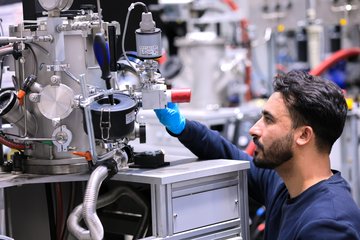All genres
21.
Journal Article
The role of carbon in the white etching crack phenomenon in bearing steels. Acta Materialia 203, 116480 (2021)
22.
Journal Article
The role of electric current in the formation of white-etching-cracks. Philosophical Magazine 101 (1), pp. 59 - 76 (2021)
23.
Journal Article
Mechanism of cementite decomposition in 100Cr6 bearing steels during high pressure torsion. Acta Materialia 201, pp. 79 - 93 (2020)
24.
Journal Article
Current Challenges and Opportunities in Microstructure-Related Properties of Advanced High-Strength Steels. Metallurgical and Materials Transactions A 51, pp. 5517 - 5586 (2020)
25.
Journal Article
Solute hydrogen and deuterium observed at the near atomic scale in high-strength steel. Acta Materialia 188, pp. 108 - 120 (2020)
26.
Journal Article
Metallic Implants: Atomic Scale Origin of Metal Ion Release from Hip Implant Taper Junctions (Adv. Sci. 5/2020). Advanced Science 7 (5), 2070027 (2020)
27.
Journal Article
Moving cracks form white etching areas during rolling contact fatigue in bearings. Materials Science and Engineering A: Structural Materials Properties Microstructure and Processing 771, 138659 (2020)
28.
Journal Article
Atomic Scale Origin of Metal Ion Release from Hip Implant Taper Junctions. Advanced Science, 1903008 (2020)
29.
Journal Article
Nanoglass–Nanocrystal Composite - a Novel Material Class for Enhanced Strength-Plasticity Synergy. Small 16 (39), 2004400 (2020)
30.
Journal Article
Microstructural origin of the outstanding durability of the high nitrogen bearing steel X30CrMoN15-1. Materials Characterization 159, 110049 (2020)
31.
Journal Article
Impact of austenite grain boundaries and ferrite nucleation on bainite formation in steels. Acta Materialia 188, pp. 424 - 434 (2020)
32.
Journal Article
Crystal–Glass High-Entropy Nanocomposites with Near Theoretical Compressive Strength and Large Deformability. Advanced Materials, 2002619 (2020)
33.
Journal Article
Quantitative affinity parameters of synthetic hydroxyapatite and enamel surfaces in vitro. Bioinspired, Biomimetic and Nanobiomaterials 8 (2), 1800035, pp. 141 - 153 (2019)
34.
Journal Article
In-situ study on fracture behaviour of white etching layers formed on rails. Acta Materialia 180, pp. 60 - 72 (2019)
35.
Journal Article
Micro fracture investigations of white etching layers. Materials and Design 180, 107892 (2019)
36.
Journal Article
Elemental re-distribution inside shear bands revealed by correlative atom-probe tomography and electron microscopy in a deformed metallic glass. Scripta Materialia 168, pp. 14 - 18 (2019)
37.
Journal Article
Atomic-scale investigations of isothermally formed bainite microstructures in 51CrV4 spring steel. Materials Characterization 152, pp. 67 - 75 (2019)
38.
Journal Article
Microstructural evolution of white and brown etching layers in pearlitic rail steels. Acta Materialia 171, pp. 48 - 64 (2019)
39.
Journal Article
In-situ observation of strain partitioning and damage development in continuously cooled carbide-free bainitic steels using micro digital image correlation. Materials Science and Engineering A: Structural Materials Properties Microstructure and Processing 757, pp. 107 - 116 (2019)
40.
Journal Article
Building a Library of Simulated Atom Probe Data for Different Crystal Structures and Tip Orientations Using TAPSim. Microscopy and Microanalysis 25 (2), pp. 320 - 330 (2019)











